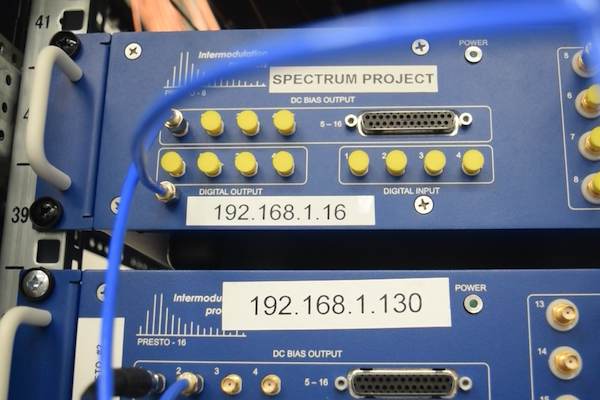
01 Apr IMP developed an FPGA-board prototype to control Quest
A significant milestone in the Spectrum project has been reached with the realization, by the partner Intermodulation Products, of a room temperature control FPGA-board prototype to control the Quest switch. FPGAs (Field Programmable Gate Arrays) are essential key for a MUX-DEMUX strategy in the QPU control, as their parallel computing capabilities are vital for the real-time signal processing needed to manage multiple inputs and outputs.
Presto (the commercial name of the FPGA board developed by IMP), initially adopted for measurements on superconducting qubits, has been enhanced to generate those all-important DC voltage pulses with nanosecond-level accurate timing, which is exactly what’s needed for effective Quest switch control.
One of the main challenges for Intermodulation Products was interfacing Presto’s high-speed digital circuitry with the device under test. This involved generating high-voltage pulses (5-50V), with fast rise times in the nanosecond range. To tackle this, the team developed a two stage amplification chain, allowing the generation of 26.5V pulses with a rise time of just 3.6 nanoseconds. This is a key achievement, providing the performance necessary for detailed studies of how the Quest switch operates.

The development process involved PCB design and circuit simulation to ensure optimal performance. Tools like TINA-TI and LT Spice were used to fine-tune the design through simulations, crucial for getting those resistor values just right and ensuring the system would be stable.
The system was then tested and validated. It was put through its paces with a semiconductor switch, demonstrating its ability to control the switch and measure important characteristics. Tests confirmed the expected behavior of the switch and showed its good isolation properties. The team also looked at the time response of the switch, with transient measurements revealing details about the switching time and the signal behavior during switching events. Notably, these tests showed a switching time of 255 ns that was close to the one specified in the data sheet. However, an additional 100 ns delay before the switch responded was discovered that was not documented, showing why transient measurements with fast measurement platform such as Presto are useful to perform.
The first amplification stage developed during Spectrum project has been a commercial success. It is both available as an option in Presto and it can be purchased separately.
While the amplifier-based solution is the focus right now, the team also explored a relay-based alternative. This could potentially offer even better performance and lower costs down the line. However, the amplifier approach was chosen for its greater flexibility at this stage of the project.
These achievements represent a significant step forward in developing the technologies needed to control quantum systems, opening new possibilities for quantum research and applications. The work by Intermodulation Products in the Spectrum project really highlights how important collaboration and innovation are when it comes to overcoming the technological hurdles in the quantum world.



